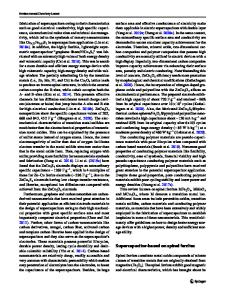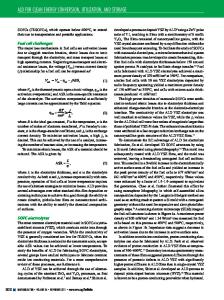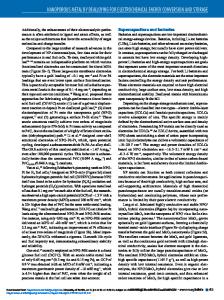Complex oxide nanomembranes for energy conversion and storage: A review
- PDF / 1,042,404 Bytes
- 18 Pages / 584.957 x 782.986 pts Page_size
- 58 Downloads / 343 Views
Oxide membranes are the foundation of several electrochemical devices and sensors, where functionality is related to selective transport of electrons and ions through a membrane or physical responses from an external perturbation. The ability to engineer power sources and sensors for the rapidly growing field of autonomous systems requires high power density and specific energy. Clamped free-standing nanoscale membranes provide an experimentally tunable platform to explore the limits of dimensionality reduction for such purposes. This review addresses the following: (i) advancing experimental methods to fabricate nanoscale oxide membranes that can sustain a chemical potential gradient, thermomechanically stable under large thermal cycles, and can be electrically interrogated with negligible parasitic loss; (ii) a representative example of high performance energy devices, solid oxide fuel cells, utilizing such membranes; and (iii) a brief discussion on emerging research directions broadly in the areas of condensed matter sciences and energy conversion and storage intersecting low-dimensional complex oxide materials. I. INTRODUCTION
Membranes that possess selective transport properties are ubiquitous in everyday life, from inorganic devices such as batteries to biological ion channels in cell walls. Though vastly different in purpose, the underlying mechanism of operation is strikingly similar. The membrane serves to separate regions of dissimilar chemical potentials and allows selective permeation of a particular species that determines the overall functionality. In this review, we will focus on the emerging field of complex oxide nanomembranes having thicknesses in the range of 10–100 nm, with particular emphasis on their use in the context of energy conversion devices. We discuss fabrication challenges and complexities involved in forming stable suspended oxide membranes and representative enabling device technologies. The oxygen ion conducting electrolyte is used as a case study in the framework of an energy conversion device, namely thin film solid oxide fuel cells (TF-SOFCs), to exemplify specific advances in device fabrication and testing, but the ideology presented is widely pertinent to many oxide material systems. Figure 1 illustrates some oxide materials that have been realized as nanomembranes to date, grouped by respective functionality.1–11 It is tremendously challenging to fabricate oxide membranes due to their inherent brittleness and the sensitivity of
Address all correspondence to this author. e-mail: [email protected] DOI: 10.1557/jmr.2013.301 J. Mater. Res., Vol. 29, No. 3, Feb 14, 2014
http://journals.cambridge.org
A. Fundamental oxide material considerations
Figure 2 presents some of the length scales and physical phenomena of interest.12 Of note is that two-dimensional crossover in complex oxides is not necessarily at the monolayer scale. Induced space charge potentials can be a function of dopant concentration, temperature, and oxygen partial pressure.13 The profile of carriers is signific
Data Loading...











